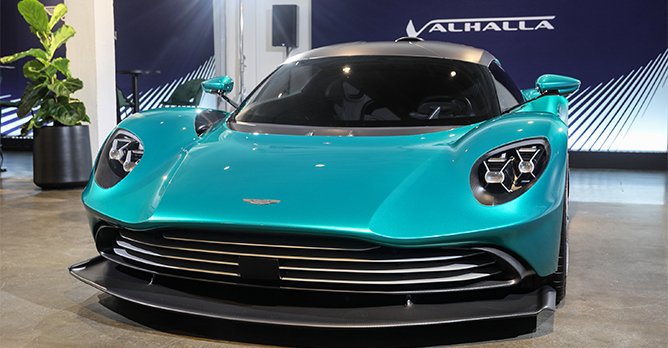A closer look at Aston Martin's road-going, hybrid supercar reveals something more
11 Apr 2022|1,025 views
When Aston Martin confirmed in 2017 that its AM-RB 001 hypercar concept would be going into production as the Valkyrie, all signs were already pointing towards a new era of visual and dynamic drama for the independent British marque.
1,140bhp from an electric motor-assisted, roaring 6.5-litre V12 engine? Co-developed with Red Bull Racing, a.k.a. the gods of Formula One? And somehow still street legal? No wonder all 150 units of the coupe were snapped up (as were the 85 Valkyrie Spiders, and 25 track-only AMR Pros), despite their seven-figure price tags. Now imagine translating an amount of that magnitude through Singapore's taxes.
The Valhalla that you see here (these are real photos - not rendered shots) officially debuted a while after, in July 2021. But with attention turning to it now, this hypercar is revealing itself to be just as important a piece to the carmaker - in that it will help to crystallise the vision that is Aston Martin's three pronged mid-engine program. A program that the Valkyrie kickstarted.
Again, we'll let the numbers speak for themselves. As a plug-in hybrid, power for the Valhalla will come from three motors: A bespoke 4.0-litre, twin-turbo V8 (borrowed from technical partner AMG and then modified in-house), coupled to two electric motors churning out 150kW. Total output is 937bhp, accelerating from standstill to 100km/h can be done within 2.5 seconds, and at 150km/h, its active aero will generate 600kg of downforce. For context, the car's targeted dry weight is 1,550kg.
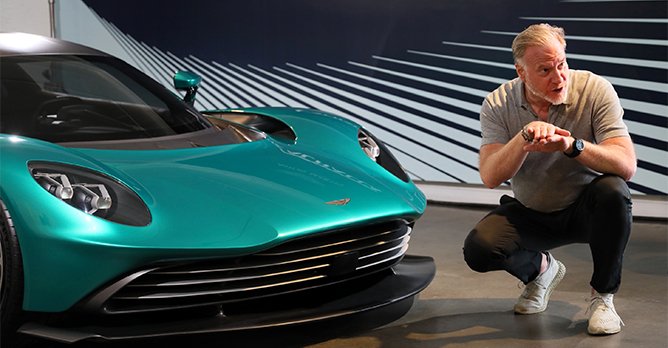
 Marek Reichman, Chief Creative Officer of Aston Martin, walking the media through the Valhalla's design in Melbourne, Australia on 7 April 2022 Features that were announced for the Valhalla - including driving assistance like Auto Emergency Braking and a 360-degree camera, as well as the really important stuff, like Apple CarPlay and dual zone A/C - all point back to Aston Martin's positioning of it as a car designed for road-use. But the marque's Chief Creative Officer, Marek Reichman, doesn't conceal the fact that it's still not what you'd call an "everyday supercar" - whatever it means to put those two diametrically opposed ideas together, anyway.
Marek Reichman, Chief Creative Officer of Aston Martin, walking the media through the Valhalla's design in Melbourne, Australia on 7 April 2022 Features that were announced for the Valhalla - including driving assistance like Auto Emergency Braking and a 360-degree camera, as well as the really important stuff, like Apple CarPlay and dual zone A/C - all point back to Aston Martin's positioning of it as a car designed for road-use. But the marque's Chief Creative Officer, Marek Reichman, doesn't conceal the fact that it's still not what you'd call an "everyday supercar" - whatever it means to put those two diametrically opposed ideas together, anyway.

After all, this car, like the Valkyrie, has also received the full Formula One treatment. One look at the car's shape and you'll know; it's all about the air flow, as Reichman tells us in the virtual briefing. The car is also built around a carbon fibre tub for "maximum stiffness with minimum weight penalty". Since the Valhalla is meant to be a bit more well-mannered than the Valkyrie, however, it ultimately dials things down - but just by a notch. It will also go into series production, unlike the Valkyrie, meaning some lucky ones among us might actually be able to get their hands on one.
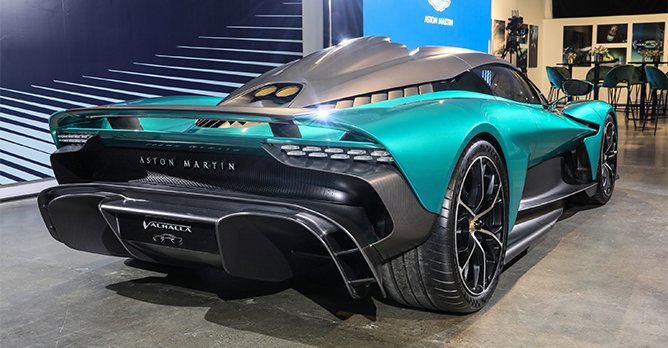
 Like the Valkyrie, technology and design principles from Formula One cars were heavily applied to the Valhalla Releasing the Valkyrie first, and then building towards the Valhalla now, means Aston Martin has chosen to cascade down to its most accessible model (more about that in a bit) rather than build up towards its performance flagship. With deliveries of the Valkyrie underway, the Valhalla's presence now is crucial in lending extra weight and credibility to the maker's mid-engine program. Reichman believes it's starting to show - "the pathway from ultra-hypercar, to hypercar, to usable supercar".
Like the Valkyrie, technology and design principles from Formula One cars were heavily applied to the Valhalla Releasing the Valkyrie first, and then building towards the Valhalla now, means Aston Martin has chosen to cascade down to its most accessible model (more about that in a bit) rather than build up towards its performance flagship. With deliveries of the Valkyrie underway, the Valhalla's presence now is crucial in lending extra weight and credibility to the maker's mid-engine program. Reichman believes it's starting to show - "the pathway from ultra-hypercar, to hypercar, to usable supercar".
That last bit - the third prong - that has yet to be unveiled officially as a production model is what the Vanquish Vision Concept from the 2019 Geneva Motorshow will become. As the usable 'everyday' supercar, it will probably go up against the likes of the McLaren GT, promising proper performance, but also proper creature comforts and sufficient practicality - such as a usable boot (the Valhalla's, in Reichman's words, is good for just two helmets and a weekend bag).
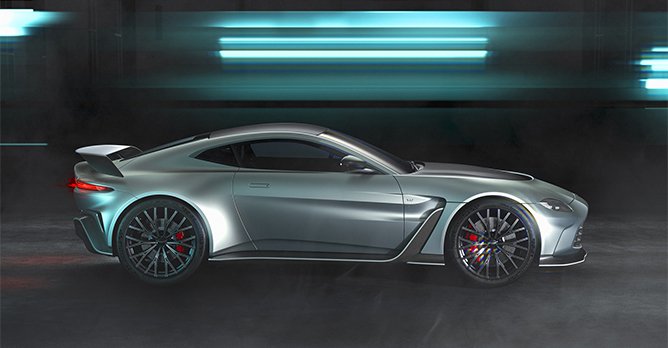
 The end of a gloriously deafening era: The upcoming Aston Martin V12 Vantage will be the most powerful and performance-oriented one yet Responding to a question from a journalist, Reichman is also lightning-quick to reject the idea that the Valkyrie and Valhalla are merely "toys for the track", churned out to add a bright but temporary spark to the British marque's line-up. Rather, he calls them "another leg to the stool".
The end of a gloriously deafening era: The upcoming Aston Martin V12 Vantage will be the most powerful and performance-oriented one yet Responding to a question from a journalist, Reichman is also lightning-quick to reject the idea that the Valkyrie and Valhalla are merely "toys for the track", churned out to add a bright but temporary spark to the British marque's line-up. Rather, he calls them "another leg to the stool".
Hardcore fans will know that front-engined, beautiful GTs with large engines have traditionally defined the brand, all the way from the svelte DB5 in Goldfinger to the snazzy DB10 in Spectre. But Aston Martin is serious about diversifying into new products. This new burst of energy has already birthed a successful SUV thus far - the DBX - and will also lead to full EVs in the future.
On the topic of EVs - inevitable, it seems, in any automotive discussion these days - there is naturally much chatter about what the future of the brand will look like. For its famed V8s and V12s, the writing is already on the wall. A video released in tandem with the recent unveiling of the final, limited-run V12 Vantage handed the spotlight over to the car's irresistible engine soundtrack fully. The title ended with the bittersweet hashtag '#NeverLeaveQuietly'.
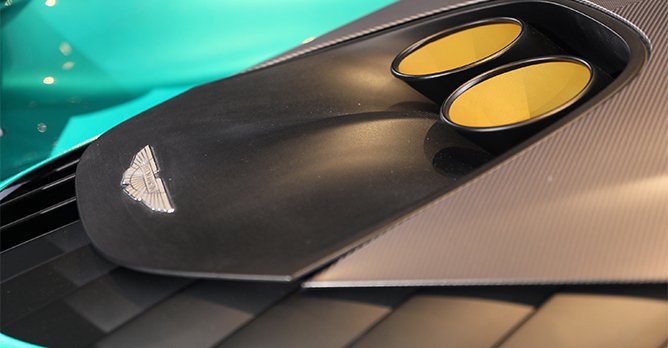
 Make no mistake: The trio of mid-engined cars will still be pure and proud representatives of the wing-badged marque through and through Reichman is reluctant to definitively answer a question on when exactly the last Aston Martin with an internal combustion engine under the hood - hybridised or not - will roll off production lines, saying that the company will hold on to them "as long as possible". Still, he is not afraid of electrification.
Make no mistake: The trio of mid-engined cars will still be pure and proud representatives of the wing-badged marque through and through Reichman is reluctant to definitively answer a question on when exactly the last Aston Martin with an internal combustion engine under the hood - hybridised or not - will roll off production lines, saying that the company will hold on to them "as long as possible". Still, he is not afraid of electrification.
"The absence of sound is sometimes just as dramatic as sound itself... A glider just has the sound of the airflow over (its body), and it's just as emotional." A strong, unmistakeable design language will continue to contribute generously to the drama and emotion associated with Aston Martins, and with electrification, new opportunities to let this flow freely will be unlocked alongside different drivetrain layouts. The Valkyrie and Valhalla, for all their innovations, still feature the signature Aston Martin-grille.
Reichman seems to acknowledge that beauty has tended to mark Aston Martins of the past more than performance. Moving forward, however, a combination of both will be "imperative". The mid-engine program, he says, is just the "beginning of the journey". Between the Valhalla and this recent record-breaker of an SUV, the beginning is looking quite rosy so far.
1,140bhp from an electric motor-assisted, roaring 6.5-litre V12 engine? Co-developed with Red Bull Racing, a.k.a. the gods of Formula One? And somehow still street legal? No wonder all 150 units of the coupe were snapped up (as were the 85 Valkyrie Spiders, and 25 track-only AMR Pros), despite their seven-figure price tags. Now imagine translating an amount of that magnitude through Singapore's taxes.
The Valhalla that you see here (these are real photos - not rendered shots) officially debuted a while after, in July 2021. But with attention turning to it now, this hypercar is revealing itself to be just as important a piece to the carmaker - in that it will help to crystallise the vision that is Aston Martin's three pronged mid-engine program. A program that the Valkyrie kickstarted.
Again, we'll let the numbers speak for themselves. As a plug-in hybrid, power for the Valhalla will come from three motors: A bespoke 4.0-litre, twin-turbo V8 (borrowed from technical partner AMG and then modified in-house), coupled to two electric motors churning out 150kW. Total output is 937bhp, accelerating from standstill to 100km/h can be done within 2.5 seconds, and at 150km/h, its active aero will generate 600kg of downforce. For context, the car's targeted dry weight is 1,550kg.

After all, this car, like the Valkyrie, has also received the full Formula One treatment. One look at the car's shape and you'll know; it's all about the air flow, as Reichman tells us in the virtual briefing. The car is also built around a carbon fibre tub for "maximum stiffness with minimum weight penalty". Since the Valhalla is meant to be a bit more well-mannered than the Valkyrie, however, it ultimately dials things down - but just by a notch. It will also go into series production, unlike the Valkyrie, meaning some lucky ones among us might actually be able to get their hands on one.

That last bit - the third prong - that has yet to be unveiled officially as a production model is what the Vanquish Vision Concept from the 2019 Geneva Motorshow will become. As the usable 'everyday' supercar, it will probably go up against the likes of the McLaren GT, promising proper performance, but also proper creature comforts and sufficient practicality - such as a usable boot (the Valhalla's, in Reichman's words, is good for just two helmets and a weekend bag).

Hardcore fans will know that front-engined, beautiful GTs with large engines have traditionally defined the brand, all the way from the svelte DB5 in Goldfinger to the snazzy DB10 in Spectre. But Aston Martin is serious about diversifying into new products. This new burst of energy has already birthed a successful SUV thus far - the DBX - and will also lead to full EVs in the future.
On the topic of EVs - inevitable, it seems, in any automotive discussion these days - there is naturally much chatter about what the future of the brand will look like. For its famed V8s and V12s, the writing is already on the wall. A video released in tandem with the recent unveiling of the final, limited-run V12 Vantage handed the spotlight over to the car's irresistible engine soundtrack fully. The title ended with the bittersweet hashtag '#NeverLeaveQuietly'.

"The absence of sound is sometimes just as dramatic as sound itself... A glider just has the sound of the airflow over (its body), and it's just as emotional." A strong, unmistakeable design language will continue to contribute generously to the drama and emotion associated with Aston Martins, and with electrification, new opportunities to let this flow freely will be unlocked alongside different drivetrain layouts. The Valkyrie and Valhalla, for all their innovations, still feature the signature Aston Martin-grille.
Reichman seems to acknowledge that beauty has tended to mark Aston Martins of the past more than performance. Moving forward, however, a combination of both will be "imperative". The mid-engine program, he says, is just the "beginning of the journey". Between the Valhalla and this recent record-breaker of an SUV, the beginning is looking quite rosy so far.
When Aston Martin confirmed in 2017 that its AM-RB 001 hypercar concept would be going into production as the Valkyrie, all signs were already pointing towards a new era of visual and dynamic drama for the independent British marque.
1,140bhp from an electric motor-assisted, roaring 6.5-litre V12 engine? Co-developed with Red Bull Racing, a.k.a. the gods of Formula One? And somehow still street legal? No wonder all 150 units of the coupe were snapped up (as were the 85 Valkyrie Spiders, and 25 track-only AMR Pros), despite their seven-figure price tags. Now imagine translating an amount of that magnitude through Singapore's taxes.
The Valhalla that you see here (these are real photos - not rendered shots) officially debuted a while after, in July 2021. But with attention turning to it now, this hypercar is revealing itself to be just as important a piece to the carmaker - in that it will help to crystallise the vision that is Aston Martin's three pronged mid-engine program. A program that the Valkyrie kickstarted.
Again, we'll let the numbers speak for themselves. As a plug-in hybrid, power for the Valhalla will come from three motors: A bespoke 4.0-litre, twin-turbo V8 (borrowed from technical partner AMG and then modified in-house), coupled to two electric motors churning out 150kW. Total output is 937bhp, accelerating from standstill to 100km/h can be done within 2.5 seconds, and at 150km/h, its active aero will generate 600kg of downforce. For context, the car's targeted dry weight is 1,550kg.

 Marek Reichman, Chief Creative Officer of Aston Martin, walking the media through the Valhalla's design in Melbourne, Australia on 7 April 2022 Features that were announced for the Valhalla - including driving assistance like Auto Emergency Braking and a 360-degree camera, as well as the really important stuff, like Apple CarPlay and dual zone A/C - all point back to Aston Martin's positioning of it as a car designed for road-use. But the marque's Chief Creative Officer, Marek Reichman, doesn't conceal the fact that it's still not what you'd call an "everyday supercar" - whatever it means to put those two diametrically opposed ideas together, anyway.
Marek Reichman, Chief Creative Officer of Aston Martin, walking the media through the Valhalla's design in Melbourne, Australia on 7 April 2022 Features that were announced for the Valhalla - including driving assistance like Auto Emergency Braking and a 360-degree camera, as well as the really important stuff, like Apple CarPlay and dual zone A/C - all point back to Aston Martin's positioning of it as a car designed for road-use. But the marque's Chief Creative Officer, Marek Reichman, doesn't conceal the fact that it's still not what you'd call an "everyday supercar" - whatever it means to put those two diametrically opposed ideas together, anyway.

After all, this car, like the Valkyrie, has also received the full Formula One treatment. One look at the car's shape and you'll know; it's all about the air flow, as Reichman tells us in the virtual briefing. The car is also built around a carbon fibre tub for "maximum stiffness with minimum weight penalty". Since the Valhalla is meant to be a bit more well-mannered than the Valkyrie, however, it ultimately dials things down - but just by a notch. It will also go into series production, unlike the Valkyrie, meaning some lucky ones among us might actually be able to get their hands on one.

 Like the Valkyrie, technology and design principles from Formula One cars were heavily applied to the Valhalla Releasing the Valkyrie first, and then building towards the Valhalla now, means Aston Martin has chosen to cascade down to its most accessible model (more about that in a bit) rather than build up towards its performance flagship. With deliveries of the Valkyrie underway, the Valhalla's presence now is crucial in lending extra weight and credibility to the maker's mid-engine program. Reichman believes it's starting to show - "the pathway from ultra-hypercar, to hypercar, to usable supercar".
Like the Valkyrie, technology and design principles from Formula One cars were heavily applied to the Valhalla Releasing the Valkyrie first, and then building towards the Valhalla now, means Aston Martin has chosen to cascade down to its most accessible model (more about that in a bit) rather than build up towards its performance flagship. With deliveries of the Valkyrie underway, the Valhalla's presence now is crucial in lending extra weight and credibility to the maker's mid-engine program. Reichman believes it's starting to show - "the pathway from ultra-hypercar, to hypercar, to usable supercar".
That last bit - the third prong - that has yet to be unveiled officially as a production model is what the Vanquish Vision Concept from the 2019 Geneva Motorshow will become. As the usable 'everyday' supercar, it will probably go up against the likes of the McLaren GT, promising proper performance, but also proper creature comforts and sufficient practicality - such as a usable boot (the Valhalla's, in Reichman's words, is good for just two helmets and a weekend bag).

 The end of a gloriously deafening era: The upcoming Aston Martin V12 Vantage will be the most powerful and performance-oriented one yet Responding to a question from a journalist, Reichman is also lightning-quick to reject the idea that the Valkyrie and Valhalla are merely "toys for the track", churned out to add a bright but temporary spark to the British marque's line-up. Rather, he calls them "another leg to the stool".
The end of a gloriously deafening era: The upcoming Aston Martin V12 Vantage will be the most powerful and performance-oriented one yet Responding to a question from a journalist, Reichman is also lightning-quick to reject the idea that the Valkyrie and Valhalla are merely "toys for the track", churned out to add a bright but temporary spark to the British marque's line-up. Rather, he calls them "another leg to the stool".
Hardcore fans will know that front-engined, beautiful GTs with large engines have traditionally defined the brand, all the way from the svelte DB5 in Goldfinger to the snazzy DB10 in Spectre. But Aston Martin is serious about diversifying into new products. This new burst of energy has already birthed a successful SUV thus far - the DBX - and will also lead to full EVs in the future.
On the topic of EVs - inevitable, it seems, in any automotive discussion these days - there is naturally much chatter about what the future of the brand will look like. For its famed V8s and V12s, the writing is already on the wall. A video released in tandem with the recent unveiling of the final, limited-run V12 Vantage handed the spotlight over to the car's irresistible engine soundtrack fully. The title ended with the bittersweet hashtag '#NeverLeaveQuietly'.

 Make no mistake: The trio of mid-engined cars will still be pure and proud representatives of the wing-badged marque through and through Reichman is reluctant to definitively answer a question on when exactly the last Aston Martin with an internal combustion engine under the hood - hybridised or not - will roll off production lines, saying that the company will hold on to them "as long as possible". Still, he is not afraid of electrification.
Make no mistake: The trio of mid-engined cars will still be pure and proud representatives of the wing-badged marque through and through Reichman is reluctant to definitively answer a question on when exactly the last Aston Martin with an internal combustion engine under the hood - hybridised or not - will roll off production lines, saying that the company will hold on to them "as long as possible". Still, he is not afraid of electrification.
"The absence of sound is sometimes just as dramatic as sound itself... A glider just has the sound of the airflow over (its body), and it's just as emotional." A strong, unmistakeable design language will continue to contribute generously to the drama and emotion associated with Aston Martins, and with electrification, new opportunities to let this flow freely will be unlocked alongside different drivetrain layouts. The Valkyrie and Valhalla, for all their innovations, still feature the signature Aston Martin-grille.
Reichman seems to acknowledge that beauty has tended to mark Aston Martins of the past more than performance. Moving forward, however, a combination of both will be "imperative". The mid-engine program, he says, is just the "beginning of the journey". Between the Valhalla and this recent record-breaker of an SUV, the beginning is looking quite rosy so far.
1,140bhp from an electric motor-assisted, roaring 6.5-litre V12 engine? Co-developed with Red Bull Racing, a.k.a. the gods of Formula One? And somehow still street legal? No wonder all 150 units of the coupe were snapped up (as were the 85 Valkyrie Spiders, and 25 track-only AMR Pros), despite their seven-figure price tags. Now imagine translating an amount of that magnitude through Singapore's taxes.
The Valhalla that you see here (these are real photos - not rendered shots) officially debuted a while after, in July 2021. But with attention turning to it now, this hypercar is revealing itself to be just as important a piece to the carmaker - in that it will help to crystallise the vision that is Aston Martin's three pronged mid-engine program. A program that the Valkyrie kickstarted.
Again, we'll let the numbers speak for themselves. As a plug-in hybrid, power for the Valhalla will come from three motors: A bespoke 4.0-litre, twin-turbo V8 (borrowed from technical partner AMG and then modified in-house), coupled to two electric motors churning out 150kW. Total output is 937bhp, accelerating from standstill to 100km/h can be done within 2.5 seconds, and at 150km/h, its active aero will generate 600kg of downforce. For context, the car's targeted dry weight is 1,550kg.

After all, this car, like the Valkyrie, has also received the full Formula One treatment. One look at the car's shape and you'll know; it's all about the air flow, as Reichman tells us in the virtual briefing. The car is also built around a carbon fibre tub for "maximum stiffness with minimum weight penalty". Since the Valhalla is meant to be a bit more well-mannered than the Valkyrie, however, it ultimately dials things down - but just by a notch. It will also go into series production, unlike the Valkyrie, meaning some lucky ones among us might actually be able to get their hands on one.

That last bit - the third prong - that has yet to be unveiled officially as a production model is what the Vanquish Vision Concept from the 2019 Geneva Motorshow will become. As the usable 'everyday' supercar, it will probably go up against the likes of the McLaren GT, promising proper performance, but also proper creature comforts and sufficient practicality - such as a usable boot (the Valhalla's, in Reichman's words, is good for just two helmets and a weekend bag).

Hardcore fans will know that front-engined, beautiful GTs with large engines have traditionally defined the brand, all the way from the svelte DB5 in Goldfinger to the snazzy DB10 in Spectre. But Aston Martin is serious about diversifying into new products. This new burst of energy has already birthed a successful SUV thus far - the DBX - and will also lead to full EVs in the future.
On the topic of EVs - inevitable, it seems, in any automotive discussion these days - there is naturally much chatter about what the future of the brand will look like. For its famed V8s and V12s, the writing is already on the wall. A video released in tandem with the recent unveiling of the final, limited-run V12 Vantage handed the spotlight over to the car's irresistible engine soundtrack fully. The title ended with the bittersweet hashtag '#NeverLeaveQuietly'.

"The absence of sound is sometimes just as dramatic as sound itself... A glider just has the sound of the airflow over (its body), and it's just as emotional." A strong, unmistakeable design language will continue to contribute generously to the drama and emotion associated with Aston Martins, and with electrification, new opportunities to let this flow freely will be unlocked alongside different drivetrain layouts. The Valkyrie and Valhalla, for all their innovations, still feature the signature Aston Martin-grille.
Reichman seems to acknowledge that beauty has tended to mark Aston Martins of the past more than performance. Moving forward, however, a combination of both will be "imperative". The mid-engine program, he says, is just the "beginning of the journey". Between the Valhalla and this recent record-breaker of an SUV, the beginning is looking quite rosy so far.
Thank You For Your Subscription.



















